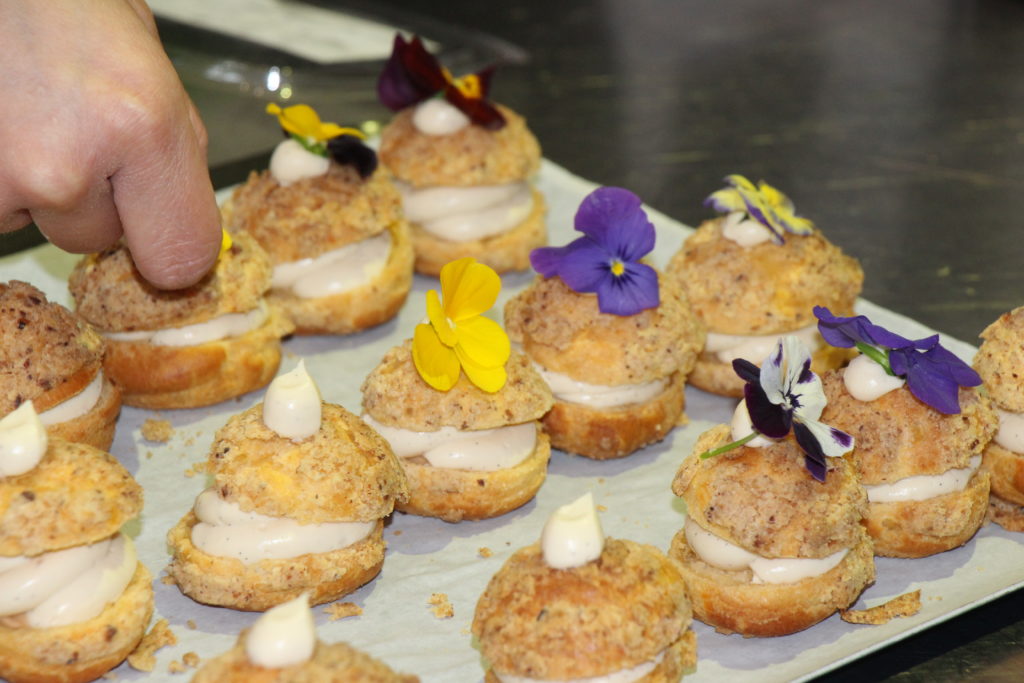The umbrella organisation for the dairy industry in France (CNIEL) has embarked on a three-year global campaign to raise awareness for its domestic dairy cream, as Michael Gordon discovered in a Tarte Tropézienne masterclass
Pastry chefs around the world, in particular those French or French-schooled, will use only French cream, because of its unique taste and texture. With a rising global interest in French pastry and a surge in new French bakeries around the world, producers are experiencing an unprecedented increase in demand for their cream.

Also known as European cream, this dairy product is immediately recognisable when sampled by its texture and highly developed aromas. It is characterised by its roundness, smoothness, and a bright and fresh taste that can sometimes let out hints of cooked milk, sweet biscuits, fruitiness and freshness.
Whether used in cooking or in pastries, European cream responds perfectly to the creative demands of chefs and pastry chefs. The delicate taste and its outstanding performance in cooking, or any preparation, are especially appreciated. It is a cream that, beyond its exceptional aerating, holding, texture, consistency and stability qualities, primarily embodies a tradition and an authenticity that has no equivalent in the world.
The culinary success of cream is due to the multiple roles it plays in improving taste, texture, binding and even presentation. Its silky, creamy, smooth and shiny texture is why the term “creamy” is so widely used by tasters to describe the smoothness of a product.
Cream enhances aromas and reveals flavours without dominating, and respects the subtlety of food. By mixing hot or cold cream with another ingredient, it will either thicken or soften the consistency of that ingredient while giving off a tangy note. It also binds and stabilises hot preparations: it will soften stuffing and egg dishes, making them more cohesive.
Other advantages of cream: it reduces the bitterness of cocoa, the acidity of lemon, and tempers the pungency of certain fruit and the astringency of others. It improves the fondant used on pastries, turns fruit into mousse, and coats the mouth to give a lasting quality to pastries that no other raw material can. Finally, its willingness to be worked results in a voluptuous cloud when whipped.
Last month, CNIEL, the French Dairy Interbranch Organisation (the umbrella organisation for the dairy industry in France) launched a three-year global campaign for dairy cream across the Middle East, which will include pastry trainings dedicated to young chefs in Dubai as well as Riyadh and Jeddah in Saudi Arabia.
Created in 1973 by French milk producers and processors to meet two key objectives, CNIEL facilitates relations between dairy producers and processors to promote a positive image of milk and dairy products across the world. Recognising the importance of this organisation the French State supports its action by making the implementation of all agreements reached by CNIEL compulsory for all dairy professionals.
Laurent Damiens, CNIEL director of communications, explains: “French, or European, cream has been exporting very well for the last five years, because of the French pastry trend that started in Japan and grew to South Korea, Taiwan, Singapore and now the Middle East – especially Dubai.
“In fact, most East Asian countries open a new French pastry style outlet almost every day.”
According to Laurent, the reason behind the success of French cream is that for more than 250 years French farmers and pastry chefs have worked together to create the best cream – one that is fatty, good in the mouth, is a great taste enhancer, has staying power and is something that can whip well. This began with Louis XIV.
Pastry Chef Sebastien Gaudard, one of today’s up-and-coming pastry chefs and owner of the famous Pâtisserie des Martyrs in Paris, worked all around the world when employed by Fauchon. For him French cream is unique because it is 100% natural, so it melts very quickly in the mouth and leaves no greasy residue. Like butter and milk, zcream is a flavour enhancer. The cream comes behind the flavour of the dessert – it doesn’t cover it. It also brings a freshness to a dish.
He states: “When we say 100% natural it means 100% milk cows and because of that the qualities are really natural, and the way it’s pasteurised today doesn’t change the flavour or quality of the cream at all.
“Plus, the cream has been developed over years with chef’s in house, working side by side with the creamery. It is specifically blended for French gastronomy. Milk, butter and cream are central to French patisseries and gastronomy around the world and so they are essential.”
Laurent adds: “Chefs have worked with industry to ensure the flavour and consistency remains the same after long-life pasteurisation. Some other creams are made with vegetable oil and this changes the taste and consistency considerably.”
It is impossible to produce or replicate French cream outside the country because of the “La Terroir”, according to Laurent.
The terroir concept suggests that in a specific area, you produce a specific milk, with specific cows, and specific people, environment, atmosphere, etc. Together they create the characteristic. “Many countries try to copy camembert but it is never the same,” argues Laurent.
Currently, Dubai imports around 2,500 tonne/year of French cream, with around 90% going to the HORECA trade, whereas in Saudi Arabia it is around 5,000 tonne/year, sold predominantly in retail. The boom in UAE imports is driven by the growth of the hotel and tourist trades, whereas Saudi Arabia has had a much more steady and even growth, in line with its population.
In China no cream was imported until three years ago and now they import 15,000 tonnes/year. Laurent says: “It has literally been an explosion. For many years Taiwan was the first to take up the trend of French pastry, for the last seven years, and it’s still increasing, but today South Korea, China and Singapore have all surpassed it.
“Exports are increasing in the US, in line with the foodie movement, and the South American market of Brazil was beginning to boom until the economic crisis. Going forward the next growth cycle will be in Africa – it is starting from a very low level now but will be rates for the future.”
You may ask how the increased demand is being met, but in actuality European farmers have had production stifled for many years to control the market and price. As Laurent explains: “In the EU there was a quota regulation on milk for more than 20 years where production was limited to regulate the price to farmers. That quota system stopped in February this year so farmers could produce more and more – and we have seen a huge rise in production.
“Now, this is driving down the price of milk globally, but it allows more cream to be produced. Also for the last 1.5 years Russia closed its doors to EU dairy products, and as it used to be a big importer there is now a surplus that we can export East.”
As part of its awareness campaign CNIEL undertakes regular training sessions for chefs and schools, both in the UAE and Saudi Arabia. “We explain how to whip cream and how to bake with it – showing different qualities of cream and different origins to show that better quality makes a difference in the end product,” says Laurent.
He adds: “One huge hurdle we face is that here [the UAE] they use blended cream with vegetable oil as it’s cheaper. Every hotel wants to reduce costs so this is competition to us, so it’s a battle. The chef can recommend European cream, but the buyers push for cost savings.”
In terms of health Laurent says: “First cream is not very fatty compared to butter or oil. The dogma of don’t eat fat has been proved wrong – there is a reverse tendency between dairy fat and heart disease. All the dietary guidelines for the last forty years were wrong – fat is not the enemy. If you don’t eat any it’s no good, as its needed for your brain, cells and muscles, but if you eat too much you are not well either. However,the right amount is absolutely necessary.
“In France we have known for many years that there was a paradox, as we eat a lot of butter, cream and cheese and we drink wine and eat bread, and yet we have lowest cardiovascular disease in the world. Then, the way we eat fat is in a food nutritional environment.
“The principal concern today is the use of palmitic oil in blended cream – in a process were the fat is taken from cream and replaced with cheap oil, which is not natural and highly processed.”
Over the next three years CNIEL will be doing a lot of demonstrations across the Middle East in a bid to educate young local chefs, and also incorporating the buyers to educate them to. We want French pastry to remain the highest quality all over the world – this is our mission. “Immediately, we will take the summit to Riyadh and Jeddah next, and later we will visit the Emirates Culinary Guild, SCAFA and ICCA.”


































































